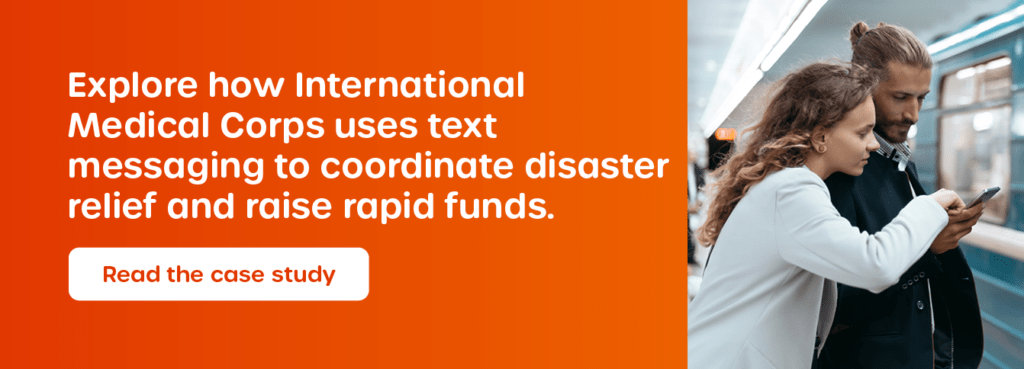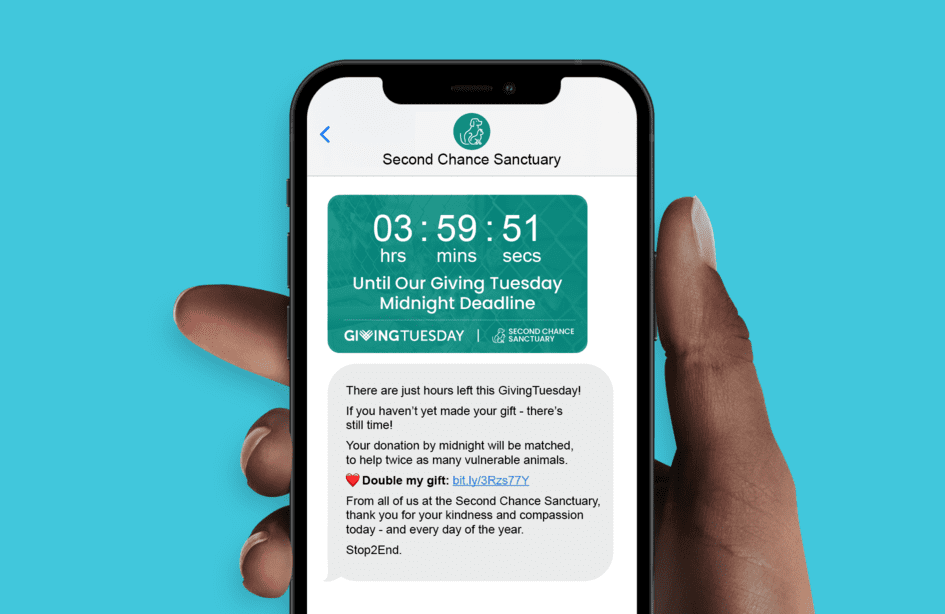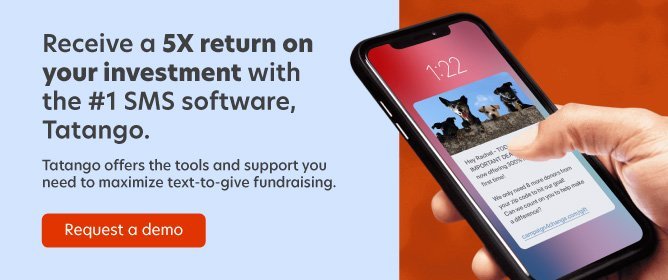
Text messaging is an integral part of daily life. The average American checks their phone around 205 times per day, and 76% look almost immediately after receiving a notification. Rather than trying to steal your audience’s attention away from their phones, your nonprofit should use this opportunity to reach donors where they’re already spending most of their time.
By developing a nonprofit text messaging strategy, you can send updates, appeals, and reminders to keep your mission at the top of supporters’ minds. In this guide, we’ll walk you through everything your nonprofit needs to know to make the most of this highly engaging communication channel. Specifically, we’ll cover:
- Text Messaging for Nonprofits: FAQs
- How to Leverage SMS for Nonprofits
- How to Launch a Text Messaging Campaign
- Best Practices for Nonprofit Text Messaging
- Additional Tools to Support Nonprofit Text Messaging
By learning how to leverage SMS for nonprofits in your fundraising and marketing strategies, you’ll expand your reach and revenue in no time.

Text Messaging for Nonprofits: FAQs
Before we jump into how your nonprofit can get started with text messaging, let’s take care of a few frequently asked questions:
What is nonprofit text messaging?
Nonprofit text messaging refers to the process of using SMS (short message service) to communicate with your nonprofit’s donors, volunteers, and more. Once you’ve built a robust contacts list, you can send personalized messages about your upcoming events, campaigns, and projects.
For a brief summary of the most common ways successful nonprofits use text messaging to further their missions, check out our video overview:
As the video explains, a text messaging strategy can help your nonprofit:
- Raise funds. Through text-to-give fundraising, donors can give directly from their phones. All they have to do is text a keyword to your nonprofit’s number to receive a link to your mobile-friendly donation page. Then, with just a few more taps on their screen, they can make a quick and convenient donation to your cause.
- Collect signatures. You can encourage more people to participate in your advocacy activities by sharing petitions via SMS. By clicking on your petition link, supporters can immediately add their signatures and make their voices heard.
- Spread awareness. Text messages are easy ways to share inspiring images and updates about your nonprofit’s impact. You can promote upcoming events, discuss open volunteer opportunities, and more—the possibilities are endless.
Unlike emails or direct mail, text messaging is a familiar, friendly, and fast channel that many donors are more than happy to respond to and act on.
Why should nonprofits use text messaging?
An SMS strategy can help your nonprofit reach its fundraising goals, retain donors, and improve engagement. The most notable benefits of nonprofit text messaging include:
High Open Rate
Subscribers who receive text messages from organizations they support open them 99% of the time. That’s four times higher than the open rate of email marketing messages, which is only 22%.
High Read Rate
90% of supporters will open your messages within just three minutes of receiving them. Compare that to social media, where even your most loyal supporters may never see your latest posts due to the ever-changing algorithms or noise online.
Personalization
Your nonprofit can use segmentation tools to target specific audiences and deliver a more authentic, one-on-one communication experience. Encourage two-way communication by inviting feedback, conducting surveys, or holding Q&A sessions via text.
Maximized Reach
The right text messaging platform will enable your nonprofit to mass-send text messages with a single click. These texts allow you to engage individual supporters with tailored, relevant content without draining your already-limited staff resources.
Automation
Many text marketing platforms for nonprofits allow you to schedule messages and set up auto-responses. For example, you might automatically send welcome texts to new contacts as soon as they opt in and thank-you notes to donors right after they give. These cutting-edge tools save you time and energy so you can focus on other mission-related priorities.
How to Leverage SMS for Nonprofits
Your nonprofit can use text messaging to enhance nearly any initiative or project. For example, you can:

- Ask for donations. Text messages can earn an immediate response from your donors, making them ideal for urgent donation appeals, GivingTuesday campaigns, and peer-to-peer fundraising. Thanks to text-to-give tools, all donors have to do is click on your donation page link to make one-time or recurring donations straight from their phones.
- Boost event engagement. Use text messages to promote upcoming events, send reminders to registrants, communicate updates as needed, and thank attendees afterward. During events, you can also use texting to engage attendees with live polls or Q&A sessions. March of Dimes, for instance, uses text marketing to boost participation during its March for Babies walk-a-thon every year.
- Manage volunteers. Through text messaging, you can broadcast open volunteer roles, share links to your volunteer registration page, and follow up with prompt thank-you messages.
- Improve donor relationships. When donors give, they want to know that their dollars are being used to make meaningful changes in their community, so transparency is key. Text messaging provides a quick and engaging way to thank donors, provide updates on their gifts’ impact, and ask for feedback to improve their giving experience.
- Share important announcements. Nonprofit text messaging is an effective channel for both internal and external communications. You can use texts to organize your teams, send emergency announcements to your donors, and inform supporters about how to get involved in your latest advocacy activities.
Assess your current marketing, fundraising, and communication strategies to get an idea of how you can incorporate text messaging to enhance your results.

How to Launch a Text Messaging Campaign
If you’re ready to start tapping into the benefits and uses of text messaging for nonprofits, follow these key steps:
Choose a nonprofit text messaging partner.
Equip your nonprofit with all the SMS tools and features you need by looking for software providers that offer:
- A2P (Application to Person) messaging. A2P messaging allows your nonprofit to mass send messages and reach all your supporters at once. This way, you’ll never have to worry about accidentally leaving anyone out of your important communications.
- Fast messaging speeds. A provider with a slow messages-per-second rate can delay your texts by hours, which isn’t ideal when working with urgent deadlines. Choose a platform that enables you to reach thousands of recipients per second after sending.
- Subscriber segmentation. Personalizing your text messages increases the chances that donors will read and respond to them. Ensure that your provider has robust segmentation capabilities so you can categorize your subscribers by location, recency of opting in, donation frequency, and more.
- Data security. If a data leak occurs, an unauthorized user can gain access to your entire contacts list or send out messages posing as your nonprofit. This can disrupt your campaigns and reduce donor trust. To avoid this, work with a software provider that offers two-factor authentication, secure sending, and automated logout to protect.
The most effective nonprofit text messaging platforms will provide all these features and more to deliver a user-friendly texting experience for both your team and supporters.
Create a keyword.
Your nonprofit SMS provider will assign you a 5-digit short code (ex: 45678) or a 10-digit long code (also called a 10 DLC). Your supporters will text this number when they opt into your messages. Then, your nonprofit will create a keyword that’s relevant to your mission or current campaign.

A keyword is a short word or phrase that donors will send to your short code or long code. When coming up with your keyword, ensure that it is:
- Simple. Choose a word or phrase that’s easy to spell. You can use numbers if relevant, but avoid spaces or special characters that might slow your supporters down or confuse them.
- Memorable. A catchy keyword will attract more interest. Plus, it’s easier for supporters to share with friends and family to get even more people signed up for your texts.
- Relevant. Your keyword should tie into your nonprofit’s mission or campaign to help supporters feel more connected to your cause and understand how their donations will make an impact on your mission.
For example, let’s say you’re an animal welfare organization running a text-to-give campaign for its shelter cats. You might choose a keyword like “COINS4CATS,” which is much more effective than a generic keyword that could apply to any nonprofit, like “DONATE.”
Build your subscriber list.
To start reaching your audience through text messaging, you first need to develop a robust list of contacts. Use the following channels to promote your short code or long code and keyword:
- Website. Create a designated page explaining how to sign up for your text messaging campaign. Then, add a call to action (CTA) button to your homepage that will easily direct supporters to this page.
- Email. Send an email about your text messaging campaign and how supporters can get involved. Highlight the benefits of opting in, such as the convenience of text-to-give and a one-on-one communication experience with your nonprofit.
- Social media. Create engaging graphics that walk supporters through opting into your text messaging campaign. You can even pair your posts with a memorable hashtag to reach broader audiences.
- Direct mail. Send postcards or brochures outlining your text messaging campaign. Point supporters to additional resources by including a QR code linking to your website’s text messaging landing page.
- Events. Add your short code and keyword to event materials so registrants can receive timely event reminders and updates. You can even have your event host or speakers encourage attendees to opt into receiving text messages during the event itself to expand your contact list.
Note that the Telephone Consumer Protection Act (TCPA) protects consumers from unsolicited communications. To avoid hefty fines, only text supporters who have opted into receiving text messages from your organization and provide the option to unsubscribe at any time.
Best Practices for Nonprofit Text Messaging
Use these best practices to inspire more supporters to get involved through text messaging:
Include one call to action per message.
Ask your supporters to take one action per message, whether that’s donating, registering for an event, or signing up to volunteer. For example, if you’re seeking donations, explain how you’ll use the funds, ask for a certain donation amount, and share a mobile-friendly donation link so donors can give right from their phones.

Use deadlines and goals to add urgency to your CTAs. Phrases like “Donate by Friday to have your gift matched!” and “Register by June 30th!” encourage supporters to take immediate action to support your nonprofit.
Use eye-catching images.
Humans understand images 60,000 times faster than text. Eye-catching images are a great way to grab your subscribers’ attention or communicate a message best conveyed visually.
For instance, capture your supporters’ hearts by showcasing exactly who their gift will help. If your nonprofit’s mission focuses on healing children, include images that show children who have benefitted from your work. Emphasize that your services would not be possible without the generous support of donors.

Optimize your donation page.
To run a successful text-to-give campaign, ensure that your nonprofit’s donation page is mobile-friendly. This way, when donors click the donation page link in your text message, they can easily fill out your form without experiencing any technical issues.
Streamline the giving process by only requesting donors’ contact information, donation amount, and billing information. You can always collect more donor details as you build relationships with them over time.
Personalize your nonprofit’s text messages.
By segmenting your texts, your nonprofit can tap into your supporters’ unique giving motivations and make them feel valued. This will help you build stronger relationships and encourage supporters to stay subscribed.
With automation tools, you can address your subscribers by name to help them feel connected to your cause. Supporters are much more likely to act on a text that’s uniquely addressed to them as opposed to a generic greeting such as “Hi Donor.”
Focus on storytelling.
Your nonprofit’s work touches the lives of many people every day, from beneficiaries to volunteers. Share these impactful stories to help potential and current supporters feel more emotionally connected to your cause. For instance, a career readiness nonprofit might explain how one beneficiary landed their dream job after participating in the organization’s resume-building and interviewing workshops.
Remember to ask for permission before sharing someone’s name, image, and story. Doing so builds more trust in your audience, demonstrating that your nonprofit respects people’s privacy and comfort.
Communicate at the right frequency.
Your text messaging cadence and frequency will depend on what your organization is trying to promote. For example, if your nonprofit participates in GivingTuesday, you’ll need to send several texts throughout the day to create urgency and encourage giving before the day is over. However, if you’re simply promoting your annual fundraising campaign, you may send only a few messages each month to keep people engaged.

Remember that your nonprofit shouldn’t only be sending donation appeals. Diversify your texts and strengthen relationships with your supporters by sharing updates about your latest projects, the results of your recent fundraising campaign, and upcoming events.
Use a multichannel approach.
Your nonprofit’s audience has varying communication preferences. Text messaging is a fast and reliable way to reach supporters, but it shouldn’t make up your entire marketing strategy. Maximize your reach by using text messages alongside emails, social media posts, and direct mail.
For example, let’s say your organization is trying to meet its GivingTuesday fundraising goal. You might first send an email explaining your campaign’s purpose and how you’ll use the funds. If you’ve secured a GivingTuesday donation match from a corporate sponsor, you’ll include these details in the email as well. Then, follow up with quick text reminders before and during GivingTuesday to maximize awareness, create a sense of urgency, and inspire more giving.
Measure your nonprofit text marketing results.
With the right software, you can create robust reports for each text message campaign. To track your results and unlock powerful insights to improve your campaign, follow these steps:
- Compare open rates with click-through rates to measure the interest level of links containing time-sensitive information.
- Pay attention to fluctuations in your subscriber list each time you send a message.
- Identify potential out-of-service phone numbers to avoid TCPA violations.
- Track the number of donors along with the total and average amount of donations received.

Messaging analytics allow you to refine your text campaign to promote more engagement. Use these metrics to determine whether you need to modify the language, length, time the message is sent, or other factors in your next text message.
Additional Tools to Support Nonprofit Text Messaging
To boost success, your nonprofit can connect its text messaging platform with powerful web services and tools like:
- Salesforce. By integrating your text messaging software with Salesforce, you can sync subscriber data with your comprehensive Salesforce database to better understand your supporters and tailor your donation appeals to each recipient.
- HubSpot. If you’re already hosting supporter data on HubSpot, you can easily migrate their phone numbers to your text messaging platform with an integration. This way, you can build up your contact list and reach your supporters quickly and reliably.
- Fundraise Up. Fundraise Up is a donation platform that helps nonprofits personalize the giving experience and drive conversions. By connecting Fundraise Up with your text messaging platform, you can capture contact and donation data and use it to segment your texts based on factors like donation frequency, recency, and amount.
- Virtuous. Virtuous is a fundraising platform that empowers nonprofits to create user-friendly and meaningful donor experiences. With its powerful automation capabilities, Virtuous collects real-time data from your subscribers and sends personalized text messages based on donor signals, ensuring that your messages inspire donors to act.
Look for a text messaging platform that will allow you to effortlessly sync your text messaging data across your nonprofit’s key tools and software. Doing so ensures that all of your donor data is centralized and ready to power your winning text messaging strategy.
Mastering SMS for Nonprofits with Tatango’s Platform
Tatango is the leading text messaging provider for nonprofits of all types and sizes. With its comprehensive functionality, Tatango has helped nonprofits raise over $500 million and meet or exceed their fundraising goals.
From simple mass texting capabilities to intuitive messaging reports to track your results, Tatango provides a unique one-on-one communication experience that drives donor engagement. With a rate of 2,000 messages per second, Tatango has the bandwidth to reliably communicate with supporters, especially around time-sensitive deadlines.
Contact our team of experts today to start building text messaging campaigns that inspire supporters to take action. Eager to learn more? Explore these additional resources for more tips and best practices on nonprofit text messaging:
- Text-to-Give: A Complete Guide to Revolutionizing Your ROI. Turn text messaging into a game-changing fundraising tool for your nonprofit using this complete guide.
- An Ultimate Guide to SMS Short Codes: How to Get Started. Learn more about the benefits of SMS short codes and how to receive one from a nonprofit text messaging provider.
- Text Donation Messages: Examples + Easy Templates. Check out these inspiring text message examples so you can strengthen your donation appeals and make a compelling case for your organization.

